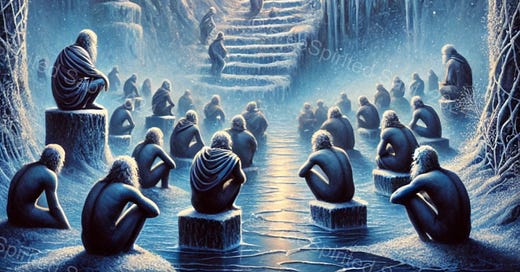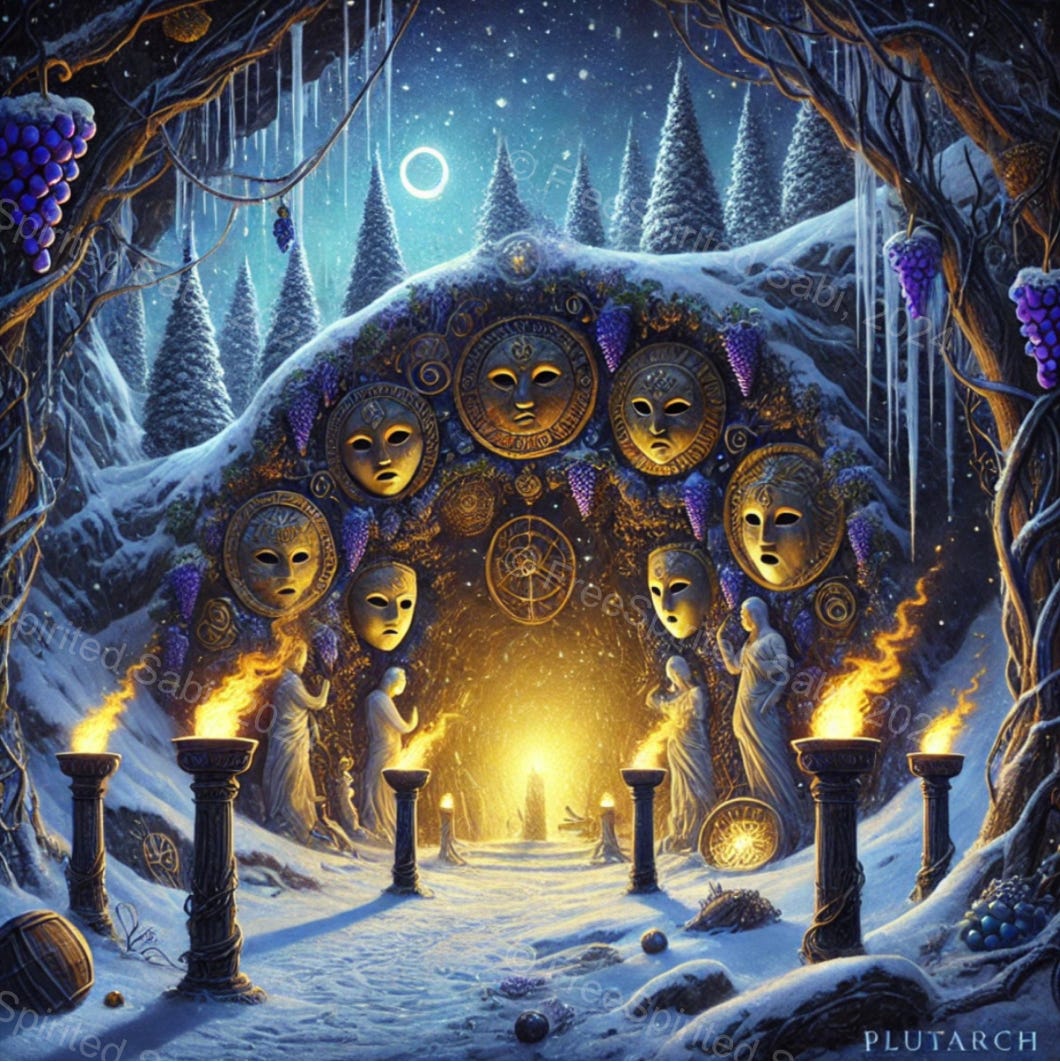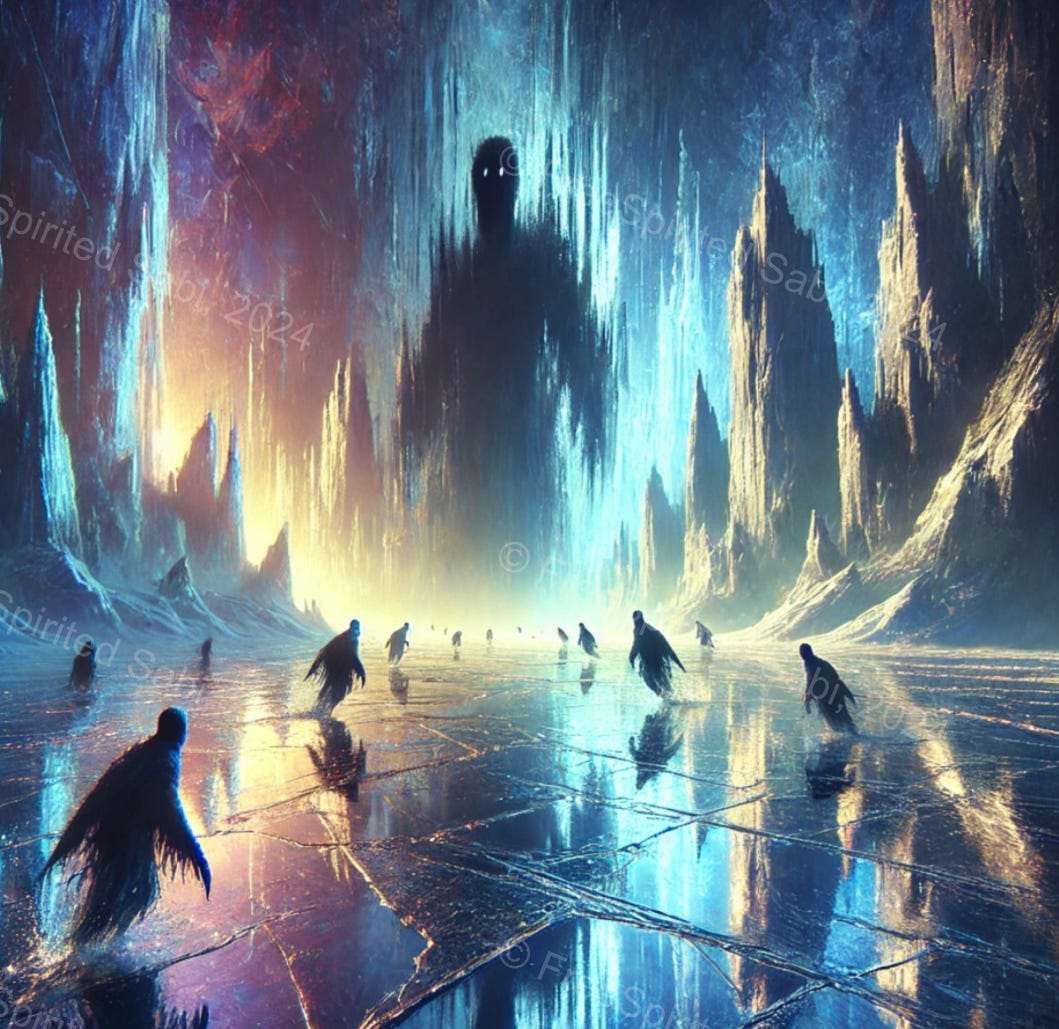The Depths of Winter - December’s Confrontation and January’s Reflection (1)
Have you done any shadow work this month? There still is time. While December’s shadow work calls us to confront buried truths, January offers the stillness to reflect and integrate.
Winter has long been recognised as a time of inward reflection, transformation, and confrontation with the unconscious. Across cultures and intellectual traditions, philosophers, poets, and mystics have used winter as a metaphor for spiritual purification and existential hardship.
Jungian psychology, too, recognises the archetype of winter as a liminal phase - both a trial and a threshold - mirroring the inner descent into darkness that precedes renewal. It is a time of dissolution, introspection, and profound transformation.
I. A Literature Review Across Time and Thought
Thinkers from Plato to Jung, Dante to Camus have interpreted winter as an essential journey for both personal and collective evolution.
1. Winter’s Intellectual Ignorance
Plato’s allegory of the cave, as presented in “The Republic”, provides an early metaphor for winter’s psychological darkness. The cave, a realm of shadows, symbolises a winter of the mind, an intellectual and spiritual state of ignorance that must be overcome through struggle and enlightenment. Prisoners must endure struggle to reach the truth. They perceive only shadows of reality, until one of them ascends into the light of truth.
The anámnesis process - where the soul recalls eternal truths - aligns with Jung’s understanding of unconscious retrieval: the deeper truths of the self emerge only after confronting darkness. Winter becomes the crucible in which this inward journey occurs.
2. Myth and the Underworld
In myth, winter is often depicted as a descent into the underworld. Persephone’s exile to Hades symbolises not just nature’s dormancy, but the psyche’s cyclical need to engage with its own depths. This is a spiritual exile and internalised suffering, yet it is this very descent that enables renewal in the spring.
Ovid’s “Metamorphoses” ties winter to transformation, emphasising how withdrawal and stillness precede metamorphosis. These myths capture the psychological necessity of shadow work - an inner exile from which renewal emerges.
Ovid’s “Fasti” further explores how January’s focus on Janus, the two-faced god of thresholds, shaped Roman psychology. Janus embodies the duality of winter, looking both forward and backward, marking a liminal time when one must reflect on the past before stepping into the future.
The Stoic philosophers reinforced the mental resilience necessary to endure winter. Seneca, in his “Letters to Lucilius”, compares winter to life’s hardships, arguing that suffering is an opportunity for purification.
The Roman Emperor Marcus Aurelius, in his “Meditations“, echoes this sentiment, describing how the mind must remain steadfast despite external hardships. In the Stoic worldview, winter represents adversity, but adversity is the foundation of self-mastery.
Plutarch, a Greek historian and philosopher, makes explicit the connection between winter, symbolic death, and transformation in “On Isis and Osiris“, where he suggests that all true change requires a period of withdrawal into darkness. Likewise, Pausanias, in “Description of Greece“, recounts Dionysian mysteries and underworld rituals performed in winter, highlighting the significance of sacred caves as spaces for dream incubation and interaction with the unconscious.
3. Winter as the “Dark Night of the Soul”
With the rise of Christian thought, winter took on a dual nature - both a trial to be endured and a time of purification that leads to enlightenment. Few thinkers illustrated this more vividly than Boethius, whose “Consolation of Philosophy“ was written during his imprisonment before execution.
Boethius compares life’s hardships to winter storms, suggesting that just as the seasons change, so too does fortune. The key to overcoming suffering, he argues, is to detach from worldly successes and cultivate inner wisdom - a process analogous to winter’s stripping away of external comforts to reveal inner truth.
Nowhere is winter’s archetypal descent into shadow more terrifyingly realized than in Dante Alighieri’s “Inferno“. At the very bottom of Hell, Dante finds Satan trapped in a frozen lake, embodying ultimate spiritual stagnation.
Unlike the fire and chaos traditionally associated with damnation, Dante’s Hell is cold, motionless, and suffocatingly still - a psychological winter of the soul where no growth is possible. Yet his journey through this frozen realm is not the end. Just as the depths of winter eventually give way to spring, Dante must pass through suffering to reach illumination in Paradise.
The Christian mystic Hildegard of Bingen saw winter not as punishment, but as a sacred time for contemplation. She believed that in the silence of winter, divine wisdom could be heard more clearly. The season’s stillness, rather than a void, was an incubator for personal transformation and divine insight.
4. Winter as Philosophical Death and Rebirth
During the Renaissance, the metaphor of winter expanded beyond religious suffering to include deep philosophical inquiry. Petrarch, in his “Ascent of Mont Ventoux“, describes climbing a mountain as an allegory for overcoming inner struggles. The bitter, cold ascent represents winter’s trials, but the summit offers enlightenment and renewal.
Marsilio Ficino, a Neoplatonist philosopher, associated winter with Saturn, the planet of melancholy, wisdom, and introspection. He believed winter’s darkness compelled the soul inward, forcing it to confront its hidden truths and undergo transformation. This mirrors Jung’s later notion of shadow work.
William Shakespeare’s “The Winter’s Tale“ illustrates this cycle of suffering, repentance, and renewal. The play’s winter serves as a period of death-like stillness, but ultimately gives way to redemption and rebirth.
5. Existential Winter and Psychological Renewal
By the 19th and 20th centuries, winter became a metaphor for existential reckoning. Søren Kierkegaard saw winter as a period of isolation necessary for authentic selfhood. For Albert Camus, winter represents absurdity and struggle, yet he ultimately affirms its inner strength in his famous line:
“In the depths of winter, I finally learned that within me there lay an invincible summer.”
Viktor Frankl, a Holocaust survivor, similarly argues that even in the harshest conditions, meaning can be found. Winter, for Frankl, is not just external suffering, but a metaphor for spiritual endurance. Rainer Maria Rilke aligns with this view, seeing winter as a time for inner growth, where one must tend to the soul’s inner garden while the outer world appears barren.
In esoteric traditions, Rudolf Steiner spoke of the “Twelve Holy Nights“ between December 25th and January 6th as a time when spiritual energies were most accessible. Helena Blavatsky, in her theosophical writings, described winter solstice festivals as ancient rituals of rebirth, aligning with the sun gods who symbolized dispelling darkness.
Finally, Carl Jung, in his exploration of the shadow, describes winter as the season of the unconscious. It is the time when what is hidden emerges, when inner work must be done. Just as nature appears lifeless but is incubating new growth, so too does the human psyche retreat to process its deepest transformations.
II. The Meaning of January in the Winter Season
In modern times, January is often framed as a month of recovery and resetting - shedding the excesses of the holidays, setting resolutions, and returning to work.
Yet, in ancient and esoteric traditions, the winter months were not a time of inactivity. The themes of the winter solstice did not abruptly end with December. Instead, they deepened throughout January, which was seen as a liminal, threshold period, an in-between space.
The solstice represented the initiatory descent into the unconscious, where the light was reborn amidst the greatest darkness. Rituals during this time were geared toward embracing the void, releasing the past, and setting intentions for rebirth.
The old year had died, yet the new year was still in its gestational phase. The return of light has begun, but its full emergence - as marked by Imbolc in early February or the coming of spring - was still distant. With the gradual return of light post-solstice, January emphasized balance: neither fully in darkness nor fully in light, it embodied the psychological tension between what is known and what remains in shadow.
Hence, stillness was sacred. The seasonal rest was considered an active process of inner gestation, mirroring the fertile stillness of winter’s soil. Like seeds buried in winter soil, the self underwent a quiet, invisible metamorphosis. January thus served as a psychological and spiritual “womb of the year,” a place where transformation was nurtured in stillness.
In preparation for spring’s return, January weaved together cycles of death and rebirth, shadow work, and ancestral connection. In the ancient times, this was especially a time for dream incubation and prophetic visioning. Dreams, symbols, and synchronicities became particularly potent during this time.
January also deepened the connection to ancestral wisdom, particularly to maternal ancestors and archetypal “fate-weavers” who represented cycles of birth, death, and renewal. This is distinct from the more general ancestral veneration associated with earlier months, as January’s focus is on weaving together the threads of destiny and transformation.
1. January as an Integration Phase
Psychologically, while December was about the confrontation with the shadow, January aligned with integration.
This phase reinforces the idea that transformation is not linear but cyclical, requiring both active work and periods of stillness. As mentioned above, purposeful rest in January is not mere inactivity. True rest, as understood in esoteric traditions, is an initiatory act that allows the psyche to digest all the material brought into consciousness during December, process its transformations and heal.
Hence, rather than initiating new change, shadow integration is a deep, hidden work of the psyche involving not only reviewing what has been uncovered, but also understanding its implications, absorbing, internalising and maturing of the insights gained.
Carl Jung referred to this as the enantiodromia of opposites - the process through which light and dark, conscious and unconscious, find balance. He mentioned that this phase was essential for individuation, emphasizing that: “The shadow must not merely be confronted but integrated into the whole personality, or it remains destructive.”
2. Alchemy
In winter’s alchemy of the soul, December, marked by the solstice, symbolizes the nigredo stage - a time of symbolic death, surrender to the darkness, and planting seeds for renewal. January carries forward the transformational momentum of this descent, acting as the solutio phase.
This phase is a crucial time of preparation and integration. In the psychological framework, the solutio or “dissolution,” represents the breaking down of old structures, patterns, egoic defenses, outdated beliefs and mental constructs.
The solutio phase is often associated with the symbolic element of Water, which has the power to dissolve boundaries and cleanse impurities. Water, in this context, represents the unconscious, the flow of emotions, and the archetypal feminine.
Hence, January’s work involves immersing oneself in the fluid, dreamlike waters of the psyche, allowing the dissolving process to clarify and prepare for renewal. Carl Jung describes this process as essential:
“Without water, there is no life. The descent into solutio is necessary to reawaken the dormant energies within the self.”
Just as ice melts into water during the slow thaw of winter, so too must the rigid ego soften into receptivity for transformation to occur. It is a process of surrender, where the ego relinquishes control and allows the unconscious to lead.
The alchemical process does not end with dissolution; instead, solutio is a preparatory phase for the next step in the opus magnum - the creation of something new from what has been broken down. Alchemists understood that true transformation could not occur without this necessary dissolution. As Jung writes:
“The gold you seek cannot be found unless you first let go of what holds you in place.”
In January, this metaphor applies to both the psyche and the larger rhythms of life. It is a time to sit with what has dissolved, trusting that the formlessness will eventually give way to a new, more integrated structure.
𑗋 Key Alchemical Themes for January
• Psychological Cleansing which reflects the psyche’s natural cycle of shedding what no longer serves.
• The Womb of Creation - a liminal space where transformation is nurtured in quiet stillness. Like an alchemical vessel, it holds the chaos of dissolution and prepares the psyche for integration.
• Archetypes of Water and the Feminine - Water is symbolic of the maternal unconscious, calling attention to feminine archetypes such as Persephone, Isis, or Sophia, who guide the psyche through its gestational phase. Their presence reminds us that transformation requires receptivity, patience, and trust in the unseen.
III. Conclusion
January, far from being a passive or transitional period, represents a profound phase of active gestation. It is the moment where the psyche weaves together the threads of shadow work, alchemical dissolution, and ancestral connection.
The slow return of the light mirrors the psyche’s integration of unconscious material into conscious awareness.
To embrace January’s alchemy is to honor the rhythms of rest, reflection, and renewal - a time when the soul, like seeds in winter’s soil, undergoes the hidden work that prepares it for the vibrant emergence of spring.
Subscribe with your email for free to access the free membership area for more articles like this.
In part 2, for paid subscribers, I will provide more detail about alchemical rituals.
.










